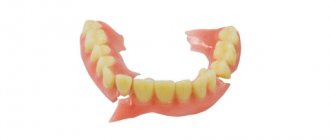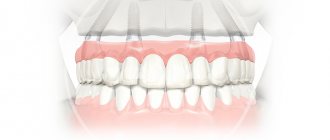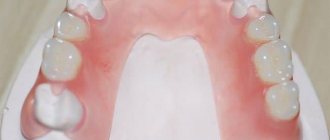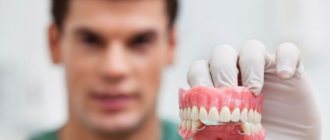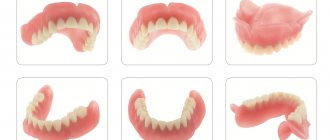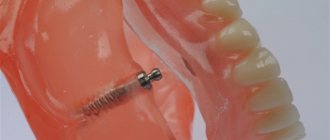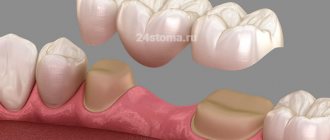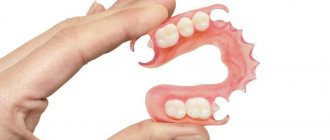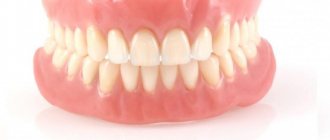Classification of elastic polymers
Elastic polymers are made from different materials:
- acrylic;
- polyvinyl chloride;
- vinyl chloride with butyl acrylate;
- siloxane or silicone;
- fluoroelastomer
Elastic polymers belong to one of two groups - plastics with high or low temperature polymerization. Available in the form of a gel, elastic sheets, a set of powder and liquid, or in the form of a laminated gel or in cartridges. The powder is a copolymer of acrylic monomers.
Molding fluid is a mixture of acrylic monomers or methyl methacrylate containing a plasticizer and some organic solvents. The second option is a liquid made from acrylic monomers - for fast-hardening plastics.
Polyvinyl chloride materials
Polyvinyl chlorides, high-temperature polymerization plastics, are available in powder-liquid configurations and in the form of a laminated gel. These materials are considered the ancestors of elastic polymers. In structure, they are copolymers of vinyl chloride with other monomers. A high degree of elasticity is achieved through external plasticization.
Such plastics resist abrasion better than silicone and acrylic, but are less attached to a rigid base. The presence of a plasticizer in the composition causes shortcomings of the material - its migration and aging.
Plastics used in orthopedic dentistry.
Story:
1839 d. Rubber vulcanization developed; Disadvantages: aesthetics, rubber quality is unsatisfactory, porous material that adsorbs oral microflora.
1865 Mr. Parker. Microcelluloid-based mass for basic dentures. Disadvantages: migration of camphor, low strength.
1921 Bakkelites. From them, phenol and formaldehyde are released during polymerization.
1937 The Külzer company solved the problem by creating the Palladon material.
1940 in the USSR AKR-7 plastics for bases based on polymethyl methacrylate.
1943 d. plastic for fixed dentures
1945 d. elastic plastic AKR-9
Now: Acrel, Ethacryl, Ftorax, Acranil, Noracryl, Sinmat, Redont, Karboplast, etc.
Medical and technical requirements.
- Strength ensures the integrity of the prosthesis.
- Necessary elasticity, eliminating defects under the influence of chewing forces.
- High stable bending resistance.
- High impact resistance.
- High thermal conductivity.
- Sufficient hardness.
- Low abrasion.
- Indifference to the action of saliva and various nutrients.
- Color fastness to solar radiation and exposure to air and environmental factors.
- Harmless to oral tissues.
- Lack of adsorbing ability for nutrients and oral microflora.
- Subject to grinding and polishing.
- Have consistency of shape and volume.
- Be bioinert (non-carcinogenic and have minimal irritating effects on tissue) and chemical resistance.
- The surface is dense, uniform, homogeneous and acid-resistant.
- Mechanical strength.
- High manufacturability of the material (easy to process and polish).
- Aesthetic properties (should restore hard and soft tissues of the oral cavity and soft tissues of the maxillofacial area.
Plastics in dentistry
- Thermoplastic. Chemical reactions do not occur under the influence of T; they harden during packaging or cooling.
- Thermosetting (thermosets). In the processing of which into a product is accompanied by the formation of a 3-dimensional polymer, then hardening, the material does not soften when reheated.
Plastics
- Irreversible (thermosets).
- Reversible (thermoplastics).
Classification by type of binder polymer
- Based on polymerization polymers (Acrylic boards, Vinyl boards, Styrene plastics).
- Based on polycondensation polymers (phenoplasts, aminoplasts, siliplasts).
- Based on modified natural polymers (Celloplasts, Promenoplasts).
- Based on natural and petroleum asphalts (Vitomoplasts).
Composition of polymer materials
Fillers . They can influence properties, impart strength, hardness, thermal conductivity, affect shrinkage, and resistance to aggressive environments.
Classification of fillers by origin.
- Mineral fillers.
- Organic fillers.
Classification of fillers by structure.
- Fiber fillers.
- Powdered fillers.
Plasticizers . To increase ductility and expand the range of highly elastic state of polymer materials. They facilitate and regulate the stickiness of the polymer composition, reduce the viscosity and formation temperature.
Stabilizers . To protect polymers from aging (various stabilizers are used depending on different influences).
- Antiozonates are inhibitors of ozone aging.
- Light stabilizers are inhibitors of photo-oxidative destruction.
- Antioxidants are inhibitors of thermal oxidative destruction.
Dyes . For producing colored polymer materials when simulating hard or soft tissues.
Stitching agents . It is introduced to create cross-links between macromolecules during processing; cross-linking (formation of cross-links) imparts strength.
Stitching agents
- Vulcanizing for rubbers.
- Hardeners for plastic.
Antimicrobial agents . Added to prevent irritation and proliferation of microbes in polymer materials present in low concentrations.
Polymerization reactions
Copolymerization.
1887 The city of Salonin. Molecules of different monomers can polymerize together. The process of forming molecules from 2 or more monomers is copolymerization, and the product is a copolymer.
By using different monomers and changing their ratios, you can change the properties of the resulting copolymers. Elasticity, strength, solubility and heat resistance change.
Block copolymers are linear copolymers, the macromolecules of which consist of alternating blocks of homopolymers that differ in composition or structure.
Graft copolymers are branched high molecular compounds, macromolecules consisting of several chemically linked sequential monomer units of the main chain and side branches. Differing in composition and structure. (Ftorax, Acronil).
Polycondensation.
Polycondensation is a process for the synthesis of polymers from bifunctional or polyfunctional compounds, in which the growth of molecules occurs through the chemical interaction of molecules with each other. Low molecular weight by-products (water, alcohols) are released.
Basic materials.
Structural materials for basic removable plate dentures are called basic materials.
Classification by purpose
- Plastics for bases.
- Plastics for soft base gaskets.
- For repairing and relining removable dentures.
- Self-curing structural plastics for the manufacture of orthodontic appliances and maxillofacial prosthetics
Requirements for base materials
- They are firmly connected to porcelain, metal-plastic (they do not form a bond between metal and porcelain), plastics are connected only mechanically.
- Radiopacity.
- Easy to repair.
- Be technologically advanced.
- Easily processed into a high-precision product.
- Can be painted and imitates the natural color of gums well.
- Should not cause an unpleasant taste, sensation or odor.
Specific requirements for base materials
- The required consistency of the polymer-monomer molding mass should be achieved in less than 40 minutes.
- The finished molding mass should be easily separated from the walls of the vessel while mixing the powder with the liquid.
- 5 minutes after reaching the required consistency it should have optimal flow properties.
- When stored for 24 hours, it should not dissolve in water. When the material is exposed to a UV lamp for hot-curing plastics for 24 hours, and cold-curing ones for 2 hours, a slight color change is allowed. The transverse deflection of hot-curing plastics with a load of 50 kg should not exceed 4 mm, and of cold-curing plastics with a load of 40 kg should not exceed 4.5 mm.
Hot curing plastics
- Ethacryl (AKR – 15) for the manufacture of denture bases, partial plate dentures, complete removable plate dentures, for orthodontic purposes.
- Ftorax of high temperature polymerization, for bases of laminar dentures. It has a pink tint, translucent, and well imitates the soft tissues of the oral cavity.
- Acranil - for the manufacture of bases for dentures, maxillofacial and orthodontic devices, for splints for periodontal diseases.
- Acrel - for the manufacture of denture tooth bases, has a three-dimensional structure, high hardness, low water absorption, and increased heat resistance.
- Colorless plastic - for the manufacture of bases for dentures and orthodontic appliances, in case of an allergic reaction to dyes, in finished form it is something like plexiglass. Insufficiently aesthetic.
- Bacryl - for the manufacture of denture bases, has good resistance to cracking, abrasion, and has a high impact strength.
- Palodont – 65 . Hot polymerization plastic for the manufacture of denture bases and splints (Külzer), good ductility after mixing, low shrinkage during polymerization.
- Sinma – M , Sinma – 74 . Has 10 polymers (10 colors) to imitate the color of hard tissues, used for making crowns. An additional 4 dyes and a transparent enamel layer are added to Sinma-M for layer-by-layer layering. For microwave polymerization (Microbase, Densplay company). Low shrinkage, conveys the relief of the prosthetic bed well.
Cold curing plastics
Cold curing (self-curing acrylic plastics). When mixing polymer/monomer 1:3 by volume, 1:2 by weight. Protocril , Protocril - M. Used for the manufacture of temporary splints, for correction and repair of removable denture bases.
Redont
Redont is available in 3 types.
- Redont is not transparent.
- Redont 0.2 unpainted transparent.
- Redont 0.3 pink transparent.
Used for correction of orthodontic appliances, repair of dentures
Acryloxyl and Carbondent are used for relining fixed crowns or bridges of prostheses.
Palaxpress and Vertex are used for the manufacture of denture bases. Slow start of polymerization 12 minutes (in the state of liquid sour cream), used for injection molding, free pouring method, polymerization under pressure in an environment of 3 atm at a temperature of 45-55 0C.
Thermoplastic injection molded plastics (group of technopolymers)
Dental-D and Acetal-Dental are made on the basis of polyoxymethylene and do not contain a monomer; they soften only when heated at T 220 0C, within 20 minutes, they acquire a working condition, after which casting is performed.
Elastic plastics
They are used for the manufacture of shock-absorbing spacers for the bases of removable dentures, for maxillofacial prosthetics, for the manufacture of accurators, for the manufacture of elastic pilots. Eladent, Ufigel. Used for clinical relining of plate dentures or denture bases. Kharkov produces PM - 0.1 (soft gasket)
Light-curing polymer materials are used for base plates of dentures, for individual trays, as an auxiliary material, for dentures that imitate hard tooth tissue.
Oxomat 0.3, Dentocollor, Artblast, Lycuplast, Chromoside, etc.
Silicone base materials
These materials are characterized by stable elasticity. The cold polymerization material is technologically advanced and can be worked with without the need for a dental laboratory. It is inert and does not swell in the oral cavity, is not susceptible to the influence of microflora on the lips, does not contain plasticizers, and therefore retains its original elasticity for several years.
Cold vulcanized silicone is a filled silicone composition in the form of a paste and a catalyst liquid. The first two liquids in the composition are vulcanization catalysts, the third is a soil adhesive. The paste contains silicone rubber and organosilicon dioxide, as well as a dye.
Silicone materials are used as a temporary soft layer for a period of up to 4 weeks. Adhesive must be used before application. The substance ages quickly and loses elasticity because it has little resistance to abrasion. Silicone polymers are characterized by insufficient adhesion to the acrylic base and low tensile strength. They are labor-intensive to correct, have weak shock-absorbing properties and are expensive. The mechanical strength of the material is increased by selecting rubber with optimal molecular weight and reinforcing fillers.
Disadvantages of elastic base polymers
- Rapid aging.
- Loss of strength and elasticity.
- Inability to polish the elastic layer - especially after correction of a denture on implants or another type.
- Unhygienic due to excessive looseness.
- Insufficient marginal contact of the elastomer with rigid base plastics.
- Difficulty in processing with cutting tools and problems with base correction.
To get rid of these shortcomings, new methods of modifying plastics are being developed, aimed at modifying the physical and mechanical properties and increasing the strength of the connection between the hard and elastic layers. Using topcoat varnishes, they improve external characteristics, reduce surface tension, and help increase the fixation of the prosthesis.
Scope of application of metal-plastic prostheses
At the Smile-at-Once clinic, metal-plastic is used to create single dental crowns or fixed bridges using one-stage implantation methods with immediate loading - basal complex, All-on-4 and All-on-6. This prosthesis is very light, which reduces the load on the installed implants.
In case of complete edentia or multiple absence of teeth, a metal-plastic prosthesis is considered adaptive or temporary. Due to the metal base, it unites the installed implants, preventing them from moving under load. It allows the patient to get used to the new teeth, and the implants to fully take root in the bone tissue.
Such a prosthesis will last no more than five years and will subsequently require replacement with a permanent structure. You need to wear it for a minimum of six months to a year - this is the time during which the implants and bone will completely grow together.
Metal-plastic dentures on an individual frame are created for a specific patient, taking into account the anatomy of his jaws, the location of implants and remaining living teeth, and the state of his bite. Orthopedists at the Smile-at-Once clinic use 3D modeling in their work, which allows them to develop a prosthesis in such a way that it is as comfortable as possible and is indistinguishable from natural teeth.
Advantages of metal-plastic prostheses
- quite high aesthetics: acrylic completely imitates natural gum, has a pink color and translucency. Plastic crowns also look very natural,
- possibility of fixation on newly installed implants, without the risk of their displacement even under load,
- simple and fast production,
- the ability to quickly correct and repair the prosthesis directly in the patient’s mouth, which is especially important if the plastic outer covering has chipped over time.
Disadvantages of dentures
Among the disadvantages of metal-plastic is its rather short service life (up to five years). After at least six months or a year (or after the structure fails), it is necessary to carry out re-prosthetics, i.e. install a permanent prosthesis. In addition, such prostheses have a metal base, so there is a certain risk of developing an allergic reaction. If there are suspicions of possible complications, the patient is recommended to inform his doctor about this and, if necessary, undergo additional examinations.
Expert opinion
Chorny Stanislav Vladimirovich Orthopedic dentist Work experience 20+
“Our clinic uses a new generation of plastic - with the addition of diamond chips, which makes it more durable and less porous. We use this material for the manufacture of prostheses with installation on implants - this is an excellent option for immediate loading. However, metal-plastic cannot be considered as a permanent prosthesis. Over time, especially with poor quality care, plaque accumulates on the crowns and the color of the artificial enamel becomes darker. The clinic provides a 1-year guarantee for such a prosthesis.”

